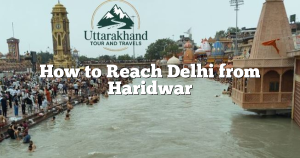Har Ki Doon is a stunning valley nestled in the foothills of the Western Garhwal Himalayas in Uttarakhand, India. Known for its lush green meadows, snow-capped peaks, crystal-clear rivers, and rich biodiversity, it’s a popular trekking destination for nature lovers, adventure enthusiasts, and spiritual seekers.
Traveling from Mussoorie to Har Ki Doon is a scenic yet involved journey that combines road travel through picturesque towns and valleys, followed by a beautiful trek to the valley itself. This article will help you plan your journey in detail.
Distance and Overview
- Distance by road from Mussoorie to Sankri: Approximately 210–230 km, the last motorable village before the trek.
- Travel time: 9 to 11 hours by road (ideal to split into two days).
- Trek length: Sankri to Har Ki Doon is approximately 14 km one way.
- Trek duration: 6 to 8 hours uphill trek from Sankri, typically done over 1-2 days with an overnight stay in the valley.
- No train or direct flights—all travel involves road travel combined with trekking.
Step-by-Step Travel Plan
Step 1: Mussoorie to Dehradun
- Distance: About 34 km
- Time: Approximately 1.5 to 2 hours by taxi or private car
- Route: Descend via the winding Mussoorie-Dehradun road, enjoying scenic Himalayan foothills.
- Transport options: Private taxi, app-based cabs, shared taxis, or local buses.
- Tips: Start early to avoid traffic jams and enjoy pleasant daylight driving.
Step 2: Dehradun to Sankri by Road
Sankri is the last road-accessible village serving as the base for treks to Har Ki Doon.
- Distance: 180–200 km
- Travel time: 7 to 9 hours (due to hilly terrain)
- Route: Dehradun → Rishikesh → Uttarkashi → Mori → Sankri
- Road conditions: Well-maintained motorable roads with winding mountain sections and beautiful river valleys. Beyond Mori township, the road narrows and winds up to Sankri.
- Transport options:
- Private Taxi or car: The preferred option for comfort and flexibility; can be booked from Dehradun.
- Buses: State-run (UTC) and Himachal Road Transport Corporation (HRTC) buses operate on segments of this route, but no direct bus from Dehradun to Sankri. One may have to change at Uttarkashi or Mori.
- Shared jeeps: Available from Mori to Sankri (sometimes from Uttarkashi or Mori).
- Overnight stay: Many trekkers break the journey at Uttarkashi or Mori to avoid long travel days.
- Tips:
- Early departure from Mussoorie and Dehradun is recommended to reach Sankri by evening.
- Weather and landslides can affect travel in monsoon (July–September); always check live updates.
- Fuel and refreshment options are available at Uttarkashi and Mori; limited after Mori toward Sankri.
- Carry warm clothes even in summer evenings due to altitude.
Step 3: Sankri to Har Ki Doon Trek
This trekking phase is the heart of your journey, offering panoramic views and serene nature.
- Trek Distance: Approximately 14 km one-way.
- Trek Duration: 6 to 8 hours uphill (can be split over two days for a leisurely pace).
- Trekking Route Overview:
- From Sankri village (1950m), the trail leads through dense pine forests, meadows, and small hamlets.
- You will cross mountain streams and climb steadily upward, enjoying views of high peaks, including Swargarohini and Black Peak.
- The final stretch opens into the alpine meadow of Har Ki Doon valley (3250m), surrounded by a horseshoe-shaped ridge.
- Accommodation:
- Basic guest houses, homestays, and camping options are available in Har Ki Doon valley.
- Booking in advance during peak season (May–June, September–October) is recommended.
- Facilities:
- Local guides and porters can be hired in Sankri.
- Stalls selling tea, snacks, and basic supplies are scattered along the route.
- Trek Tips:
- Prepare for high altitude conditions; stay hydrated and pace yourself.
- Trek boots, warm layered clothing, rain gear, and trekking poles are advisable.
- Carry sufficient water and snacks, though supplies are available en route.
- Mobile connectivity is very limited; inform someone about your trek plan.
- Camp or stay overnight in the valley before returning or moving on to adjoining trails.
Best Time to Visit Har Ki Doon from Mussoorie
- April to June: Ideal weather conditions, moderate temperatures, clear skies.
- September to October: Post monsoon clear weather and beautiful autumn colors.
- July to August (Monsoon): Can be lush and green but prone to landslides and slippery trails; travel with caution.
- November to March: Harsh winters with snow blocking trails; typically not recommended for trekking unless very experienced and equipped.
Local Sightseeing & Nearby Attractions
- Har Ki Doon Valley: Famous for its alpine meadows, wildlife, and Himalayan views.
- Swargarohini Peak: Visible from the valley; a holy Himalayan peak featured in Hindu scriptures.
- Khatling Glacier and Khatling Base Camp: An extension trek from Har Ki Doon for adventurers.
- Tosh Glacier: Another nearby trek to explore from this region.
- Uttarkashi Town: Known for spiritual centers and as a hub on the way to Sankri.
Accommodation Options for Enroute and Trek
- Dehradun: Wide range of hotels, from budget to premium.
- Uttarkashi/Mori: Several guest houses, hotels, and homestays.
- Sankri: Basic trekking guesthouses and campsites; bookings recommended during peak season.
- Har Ki Doon: Camps, eco-huts, and guesthouses with simple facilities.
Frequently Asked Questions (FAQs)
Q1: What is the best way to reach Har Ki Doon from Mussoorie?
A: The best way is to travel from Mussoorie to Dehradun by road, then from Dehradun to Sankri by taxi or bus, followed by a trek of approx. 14 km to Har Ki Doon valley.
Q2: Can the entire journey be done in one day?
A: No. Considering distance and trek duration, the journey is best split over 2-3 days with overnight stays at Dehradun/Uttarkashi/Sankri.
Q3: Is the trek to Har Ki Doon suitable for beginners?
A: The trek is moderate. While it can be done by those with average fitness, beginners should acclimatize properly and consider hiring guides.
Q4: What permits are required?
A: No special permits are needed for Har Ki Doon trek. However, hiking with a guide and registration at Sankri is recommended for safety.
Q5: Can the trek be done year-round?
A: No. Monsoon and winter seasons can make the trek difficult or impossible due to weather conditions.
Q6: Are there guides and porters available?
A: Yes, available for hire in Sankri village.
Additional Practical Tips
- Carry cash as ATMs and card payments are unavailable along the trek.
- Dress in layers; weather can change rapidly at altitude.
- Pack a basic first-aid kit and any personal medications.
- Inform friends or family about your trek plans.
- Respect local culture and natural environment; dispose of waste properly.
Sample Itinerary Suggestion
| Day | Itinerary |
|---|---|
| Day 1 | Mussoorie → Dehradun → Uttarkashi (overnight stay) |
| Day 2 | Uttarkashi → Sankri (overnight stay) |
| Day 3 | Sankri → Har Ki Doon (trek and overnight stay) |
| Day 4 | Har Ki Doon → Sankri (trek) → return journey |
Summary Table
| Segment | Distance | Approximate Time |
|---|---|---|
| Mussoorie to Dehradun | ~34 km | 1.5–2 hours |
| Dehradun to Sankri | ~180–200 km | 7–9 hours |
| Sankri to Har Ki Doon Trek | ~14 km (trek) | 6–8 hours (one way) |
Conclusion
Traveling from Mussoorie to Har Ki Doon offers a perfect mix of Himalayan road journey, serene towns, and an enriching trek to one of the most beautiful valleys in Uttarakhand. For a memorable and comfortable experience, plan your journey carefully with overnight stops in Dehradun, Uttarkashi, and Sankri. The reward is breathtaking mountain scenery, rich flora and fauna, and a peaceful Himalayan refuge.









